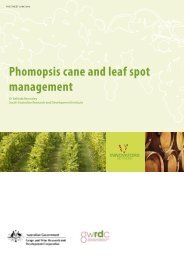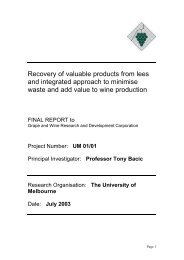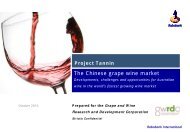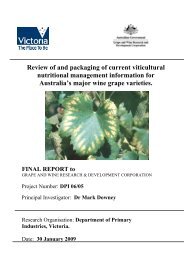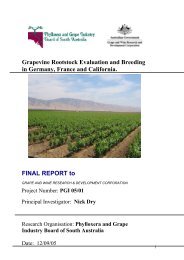Identification of the major drivers of 'phenolic' taste in ... - GWRDC
Identification of the major drivers of 'phenolic' taste in ... - GWRDC
Identification of the major drivers of 'phenolic' taste in ... - GWRDC
You also want an ePaper? Increase the reach of your titles
YUMPU automatically turns print PDFs into web optimized ePapers that Google loves.
AWRI: <strong>Identification</strong> Of The Major Drivers Of ‘Phenolic’ Taste In White W<strong>in</strong>es<br />
pH w<strong>in</strong>e failed to substantially <strong>in</strong>crease its astr<strong>in</strong>gency. Phenolics also only significantly <strong>in</strong>creased<br />
hotness when <strong>the</strong> w<strong>in</strong>e was at <strong>the</strong> lower end <strong>of</strong> alcohol <strong>in</strong> dry white w<strong>in</strong>es (11.4%). At 12.6% alcohol, <strong>the</strong><br />
effects <strong>of</strong> phenolics on hotness were far less pronounced. Overall, low pH levels produced w<strong>in</strong>es that<br />
were more astr<strong>in</strong>gent, hot and bitter, and <strong>in</strong>creased alcohol resulted <strong>in</strong> w<strong>in</strong>es that were more hot and bitter.<br />
Therefore, <strong>the</strong>se two fundamental aspects <strong>of</strong> pH and alcohol <strong>in</strong> <strong>the</strong> w<strong>in</strong>e matrix were shown to have an<br />
overarch<strong>in</strong>g effect on those <strong>taste</strong>s normally associated with phenolics – <strong>of</strong>ten greater than <strong>the</strong> phenolics<br />
<strong>the</strong>mselves.<br />
In moderately alcoholic w<strong>in</strong>es made us<strong>in</strong>g a range <strong>of</strong> commercial practices, perceived astr<strong>in</strong>gency and<br />
viscosity were more strongly <strong>in</strong>fluenced by pH than by phenolic level. As <strong>the</strong> degree <strong>of</strong> sk<strong>in</strong><br />
contact/maceration <strong>in</strong>creased, so did total phenolics and pH. The higher pH (and phenolic) w<strong>in</strong>es were<br />
perceived to be less astr<strong>in</strong>gent, more viscous and more bitter.<br />
To date, w<strong>in</strong>eries have generally measured phenolics as a total ‘pool’ us<strong>in</strong>g simple spectrophotometric<br />
methods i.e. absorbance at 280 and 320 nm. Any conclusions drawn from <strong>the</strong>se measures must<br />
necessarily assume that all phenolic species that absorb at <strong>the</strong>se wavelength have a similar <strong>taste</strong> impact.<br />
This is not likely to be <strong>the</strong> case. While add<strong>in</strong>g whole phenolics to w<strong>in</strong>e generally <strong>in</strong>creases phenolic<br />
<strong>taste</strong>s, <strong>the</strong> presence <strong>of</strong> some important phenolic species that absorb at <strong>the</strong>se wavelengths appear to have a<br />
suppressive effect also. Therefore, <strong>in</strong> light <strong>of</strong> this f<strong>in</strong>d<strong>in</strong>g, better rapid analytical methods for measur<strong>in</strong>g<br />
key phenolic subcomponents or classes associated with sensory impacts are required.<br />
F<strong>in</strong>ally, <strong>the</strong> knowledge that different phenolics or phenolic classes ei<strong>the</strong>r add or suppress different <strong>taste</strong>s<br />
aris<strong>in</strong>g from phenolics <strong>the</strong>mselves or from <strong>the</strong> <strong>in</strong>fluence <strong>of</strong> pH or alcohol, could warrant <strong>in</strong>vestment <strong>in</strong> <strong>the</strong><br />
development <strong>of</strong> f<strong>in</strong><strong>in</strong>g agents that are tailored to modify <strong>the</strong> <strong>taste</strong>s and textures <strong>of</strong> white w<strong>in</strong>e through<br />
removal <strong>of</strong> key phenolics, or alternatively, may lead to a more effective use <strong>of</strong> exist<strong>in</strong>g f<strong>in</strong><strong>in</strong>g agents.<br />
Future Research Recommendations and Opportunities<br />
Fur<strong>the</strong>r opportunities for research <strong>in</strong>to <strong>the</strong> molecular basis for phenolic <strong>taste</strong> exist. Of particular relevance<br />
is bitterness, which was one <strong>of</strong> <strong>the</strong> few sensory attributes clearly attributable to phenolics but <strong>the</strong><br />
molecular <strong>drivers</strong> rema<strong>in</strong> unknown. Suppressive effects on alcohol hotness and <strong>in</strong>creases <strong>in</strong> oil<strong>in</strong>ess from<br />
GRP-like compounds may also present opportunities.<br />
While <strong>in</strong>vestigat<strong>in</strong>g ways <strong>of</strong> fractionat<strong>in</strong>g caftaric acid and GRP from w<strong>in</strong>es us<strong>in</strong>g counter-current<br />
chromatography we identified potential new ways <strong>of</strong> fractionat<strong>in</strong>g phenolic compounds identified <strong>in</strong> our<br />
o<strong>the</strong>r studies as potential <strong>drivers</strong> <strong>of</strong> <strong>the</strong> negatively perceived characters <strong>of</strong> bitterness and metallic <strong>taste</strong>.<br />
The new HPLC method developed as part <strong>of</strong> this project can be used to assess <strong>the</strong> composition and purity<br />
<strong>of</strong> any resultant fractions submitted to sensory assessment.<br />
97




